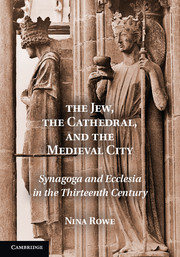Introduction: The Jew, the Cathedral, and the Medieval City
Published online by Cambridge University Press: 05 January 2012
Summary
In the second quarter of the thirteenth century, images of a beautiful and benighted Judaism began to appear on cathedral façades across northern Europe. In the sculpted decorative programs of the most ambitious ecclesiastical building projects of the age, the Synagogue, personified as a comely lady, was paired with a likewise feminine personification of the Church. Known as Ecclesia and Synagoga, these personae became hinge figures within the monumental sculpted ensembles that dominated the public space at city centers in the French kingdom and the German empire. These urban milieux were sites of lively economic and social exchange, where local Christian burghers, traveling merchants, mendicant clerics, visiting pilgrims, itinerant artists, insurgent preachers, and Jewish men and women traded, argued, observed, and engaged one another in the course of daily life. Poised above the motley populace were the sculpted figures conveying Christian triumph and Jewish defeat. On cathedral façades, Ecclesia typically is shown crowned and holding a battle standard and chalice. Synagoga, in contrast, is blindfolded and drooping; she holds a broken staff and is dropping the tablets of the law. The images of Synagoga that bedecked cathedral exteriors stood in stark contrast to the real Jews living in streets at the heart of Europe's cities in the High Middle Ages. While Ashkenazic communities of the twelfth and thirteenth centuries were strong contributors to a still-celebrated flowering of Jewish intellectual, spiritual, and economic life, Synagoga consistently was represented in monumental public sculpture as an incapacitated and downtrodden figure.
- Type
- Chapter
- Information
- The Jew, the Cathedral and the Medieval CitySynagoga and Ecclesia in the Thirteenth Century, pp. 1 - 12Publisher: Cambridge University PressPrint publication year: 2011



